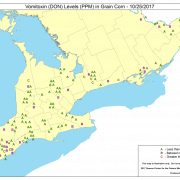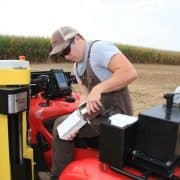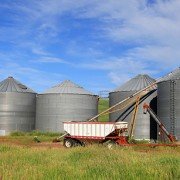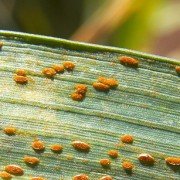A long career with Thompsons
/in News/by Ryan MortierWe wish you a happy retirement Ace. Thank you for your 45 years of dedicated service to our company, and to our customers in Port Albert.
A great turnout for Ace’s last day as a @PortAlbertBrnch employee. 45 years later – a well deserved retirement! Congrats Ace, we wish you all the best! #retirement #45years pic.twitter.com/ljN0Xki5P2
— Thompsons PortAlbert (@PortAlbertBrnch) December 4, 2017
Understanding in-field variability: soil sampling
/in Agronomy, News/by Agronomy TeamWritten by Alex Richardson, Agricultural Consultant, Thompsons – Blenheim.
Wheat harvest is complete and yields have given us great insight about our fields once again.
Variability was evident, and the results remind us it’s time to soil sample.
Soil sampling after wheat harvest is a great option to allow for the right conditions, and the time to do the sampling properly. It gives us the ability to plan using these results–not only for the remaining growing year, but for next year as well.
Results gathered now can be reviewed and used to apply some fall fertilizer or make spring plans for fertility management. Knowing what nutrients are already in the field is the best way to start that process.
Thompsons offers 3 main soil sampling packages, with options to suit any grower and any field.
Intensive Zone Sampling
Using data from numerous sources, grower expertise, and your local Thompsons Agricultural consultant, management zones will be mapped and generated throughout the field. Soil samples will be taken across these zones to best represent the field following the topography, yield, or problem areas depicted in the zones.
Site-specific Sampling
Choose from a 1 acre, 2.5 acre or 5 acre sample area. Your field will be overlaid with a grid, followed by samples taken in each grid from an area that best represents the lay of the land within that grid space.
Precision-Lite Sampling
Generate larger zones across the field to sample. Zones range from 10 acres to 25 acres in size, again based on numerous sources and grower expertise. Monitor and map the variability in your field!
Talk to your local Thompsons Agricultural Consultant today about any of these sampling packages and customized options. We can build a soil sampling plan to suit your individual farm and management situation.
We all know our fields are variable and need to continue managing the variability on our farms!
All soil sampling options include a complete mapbook of your field and soil analysis, with lab results attached.
Once the results have come from the lab, the value of soil sampling begins as fertility management progresses. With the help of your local Thompsons Agricultural Consultant, your field’s fertility can be reviewed and a plan put in place to build and maintain your soil health.
Late season nitrogen application
/in Agronomy, Technology/by Agronomy Team Late season nitrogen application has been a hot topic amongst farmers and uptake in this practice has increased in recent years. The expense and environmental impact has made growers think differently about nitrogen application.
Late season nitrogen application has been a hot topic amongst farmers and uptake in this practice has increased in recent years. The expense and environmental impact has made growers think differently about nitrogen application.
Weather extremes has also caused growers to change the way they apply nitrogen to mitigate loses from excessive rainfall when applying all their nitrogen ahead of planting. Read more
Preparing grain bins for harvest
/in Agronomy, Grain Marketing, Safety/by Head OfficePreparing grain bins for harvest should be done to maintain the quality of grain and to make sure the areas around bins are ready for the busy season ahead. It is also a good time to inspect any mechanical components and clean up around the bin. Simple maintenance and safety rules will make sure we don’t experience any difficulties in the season ahead.
A key reason why people become entrapped in grain is because grain stored in bins is spoiled. Making sure that the bins are ready to be loaded with newly harvested grain reduces the risk of spoilage. If the grain is in good condition, people don’t have to enter the bin, reducing the risk of entrapment. Read more
Heat stress
/in Agronomy, Grain Marketing, Safety/by Head OfficeHeat stress can be a killer on the job site. Outside of the direct consequences such as heat stroke, heat stress can cause incidents due to loss of focus or excessive fatigue on the job.
Heat-related illnesses
Heat cramps
Heat cramps are painful, brief muscle cramps. Muscles may spasm or spasm involuntarily. Heat cramps can occur during exercise or work in a hot environment or begin a few hours later.
Heat exhaustion
There are two types of heat exhaustion. Read more
Wheat leaf diseases
/in Agronomy/by Agronomy TeamWhat increases the risk of infection?
- Cool temperatures
- Prolonged periods of wet weather
- Rust problems in the southern US states and Mexico could mean the same for Ontario as storm systems carry the spores north
- Planting susceptible varieties.Planting after another cereal or corn crop.

How do I know when to apply a fungicide?
Delicious brownies made from black beans – recipe
/in Food/by Ryan MortierHave you ever imagined you can make delicious brownies using dry black beans?
Here’s a recipe that will allow you do just that – and satisfy your sweet tooth at the same time.
Once you start working with dry beans, it’s a snap.
Pro Tip: You can always soak then cook your dry beans ahead of time, and then freeze them to use later or when you need them quickly.
First things first. Soak your beans.
Dry beans need to be soaked before cooking in order to replace moisture. Here are 3 methods to get this done.
- Quick soak: Bring 6 cups of cold water and 450 g (2 cups) of beans to a boil, cover and boil for 2 minutes. Remove from heat and let stand 1 hour. Drain.
- Overnight soak: Let beans and water stand overnight. Drain.
- Microwave soak: Combine 6 cups (1.5 L) of hot water and 450 g (2 cups) of dry beans in a 8 qt. (8 L) microwaveable casserole dish. Cover and microwave at HIGH (100%) power for 15 minutes or until boiling. Let stand 1 hour. Drain.
Cook your beans.
To cook soaked beans, use 6 cups of fresh water for every 2 cups of soaked beans. Then follow one of these two methods:
- Conventional cooking: In a large saucepan, combine soaked beans and water. Cover and bring to a full boil. Reduce heat and simmer until fork tender, about 45 to 60 minutes.
- Microwave cooking: In a 8 qt. (8 L) microwaveable casserole dish combine 6 cups (1.5 L) of water and 2 cups (450 g) of soaked beans
Brownie recipe
Ingredients:
- 1080 mL (4.56 cups) of cooked black beans
- 6 eggs
- 1/3 cup coconut or canola oil
- 1/2 cup cocoa powder
- 1 tbsp. vanilla
- 1 cup maple syrup or honey
- 1 cup bittersweet chocolate chips
Topping:
- ½ cup chocolate chips
Method:
- Rinse, soak and cook dry beans (see above soaking and cooking instructions for details).
- Cook beans until they are soft (see cooking method for details).
- Combine everything except chocolate chips in a food processor (or blender) and process until smooth.
- Fold in chocolate chips.
- Spread into a greased 9″ x 13″ pan.
- Bake at 350°F for 45 to 50 minutes.
- As soon as you take it out of the oven, sprinkle the topping (chocolate chips) on and they will melt.
Let cool completely before cutting.
To be leaders in the food and agribusiness sector through sustainability, integrity, relationships, employee engagement, profitability and innovation.










